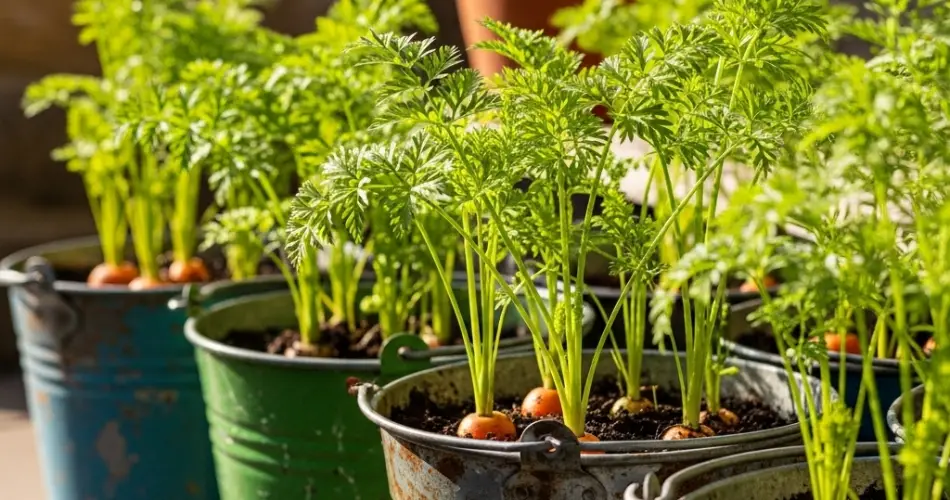Carrots are a nutritious and versatile vegetable that can thrive in small-space gardens using bucket containers. Growing carrots in buckets is perfect for urban dwellers, balcony gardeners, and anyone with limited outdoor space. With the right container, soil, and care, you can enjoy a steady supply of fresh, homegrown carrots even without a traditional garden bed.
Choosing the Right Bucket
The first step to growing carrots successfully is selecting an appropriate container. Carrots develop long taproots, so choose a bucket or container that is at least 12 inches deep to accommodate root growth. Wider buckets allow multiple plants to grow together while ensuring each carrot has enough space to develop fully.
Ensure the container has drainage holes to prevent waterlogging, which can lead to root rot and stunted growth. Lightweight plastic buckets are easy to move for optimal sunlight, while terracotta or ceramic containers retain moisture but may require more frequent watering during hot weather.
Preparing Soil for Carrots
Carrots thrive in loose, well-draining soil. A high-quality potting mix enriched with compost or organic matter provides essential nutrients while maintaining adequate moisture. Avoid heavy clay soils, which can restrict root growth and produce misshapen carrots.
Adding perlite, vermiculite, or coarse sand improves soil aeration, prevents compaction, and supports healthy root development. Carrots prefer slightly acidic to neutral soil, with a pH between 6.0 and 7.0. Fill the bucket to about an inch below the rim to leave room for watering and mulching.
Mulching with straw or shredded leaves helps retain moisture, regulate soil temperature, and suppress weeds, creating optimal conditions for carrot growth in containers.
Selecting Carrot Varieties
Several carrot varieties perform well in container gardening. Short or intermediate types, such as ‘Thumbelina,’ ‘Little Finger,’ and ‘Danvers Half Long,’ are ideal for balcony buckets, as they do not require extremely deep soil. Selecting the right variety ensures uniform growth and easier harvesting.
Planting Carrots in Buckets
Carrots are typically grown from seeds sown directly into the container. Plant seeds about ¼ to ½ inch deep and space them 1–2 inches apart. Once seedlings reach 2–3 inches in height, thin them to 2–3 inches apart to allow proper root development.
After planting, water the soil gently to settle the seeds and encourage germination. Consistent moisture during the early stages of growth is crucial for even root formation and tender, sweet carrots.
Watering and Moisture Management
Container-grown carrots require consistent moisture. The soil should remain evenly damp but not waterlogged. Overwatering can cause root rot, while underwatering may produce tough, fibrous roots. Buckets dry out faster than garden beds, so check soil moisture regularly.
Water in the morning to allow foliage to dry during the day, reducing the risk of fungal diseases. Mulching helps retain moisture, keeps soil temperatures stable, and reduces the frequency of watering.
Sunlight Requirements
Carrots require full sunlight to grow optimally, ideally 6–8 hours per day. Place buckets in a sunny location on a balcony or patio to promote strong roots and healthy foliage. In hot climates, partial afternoon shade can prevent heat stress and maintain consistent growth.
Fertilization and Care
Carrots are light feeders but benefit from nutrient-rich soil. Incorporate compost or a balanced, slow-release fertilizer before planting to support root development. Avoid excessive nitrogen, which encourages leafy growth at the expense of root formation.
Remove yellowing or damaged leaves to maintain airflow and reduce disease risk. Proper care ensures container-grown carrots remain productive and healthy throughout the growing season.
Harvesting Carrots
Carrots are usually ready to harvest 60–75 days after planting, depending on the variety. Gently pull carrots from the soil once they reach the desired size. For a continuous harvest, plant new seeds in succession every few weeks.
Harvesting promptly prevents roots from becoming woody or overly large and ensures a steady supply of fresh, flavorful carrots.
Benefits of Bucket Carrot Gardening
Growing carrots in buckets offers numerous advantages for small-space gardeners. Containers allow control over soil, water, and sunlight while reducing exposure to pests and soil-borne diseases. Carrots are easy to grow, rewarding, and provide fresh, homegrown produce even in urban environments.
By selecting the right container, preparing nutrient-rich soil, maintaining consistent watering and sunlight, and following proper planting and harvesting techniques, gardeners can enjoy a productive carrot harvest on balconies or patios. Container gardening transforms small spaces into productive vegetable gardens, delivering fresh, homegrown carrots year-round.



